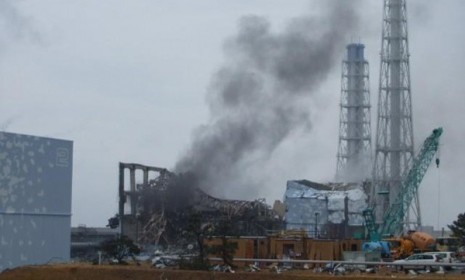Is it safe for Fukushima to dump radioactive water into the sea?
Japan pumps contaminated water from the tsunami-damaged Fukushima nuclear plant right into the Pacific Ocean. An instant guide

Japan's government agreed on Monday to let the Fukushima Daiichi nuclear plant dump more than 3 million gallons of radioactive waste-water directly into the Pacific Ocean — a lesser-of-two-evils solution given that the Tokyo Electric Power Co. (TEPCO), which operates the reactors, plans to use the emptied storage tanks to hold the much more radioactive water that's already gushing into the ocean through cracks in the reactors. But is it the best TEPCO can do? Here, a brief guide.
How contaminated is the water being pumped into the ocean?
About 100 times more radioactive than Japanese law allows. Still, experts don't expect it to harm sea life... yet. "It's a very large ocean," says Florida State University's William Burnett. But "even if they say the contamination will be diluted in the ocean, the longer this continues, the more radioactive particles will be released and the greater the impact," says chief government spokesman Yukio Edano.
The Week
Escape your echo chamber. Get the facts behind the news, plus analysis from multiple perspectives.

Sign up for The Week's Free Newsletters
From our morning news briefing to a weekly Good News Newsletter, get the best of The Week delivered directly to your inbox.
From our morning news briefing to a weekly Good News Newsletter, get the best of The Week delivered directly to your inbox.
What about the more highly radioactive water that's leaking?
It has been measured at about 10,000 times the levels of radiation normally found at nuclear facilities, and, every hour, 7 tons of it is pouring into the ocean from flooded underground tunnels and storage rooms in the reactors. Workers tried to fill cracks over the weekend with cement, then a mixture of sawdust, shredded newspaper, and polymer, but that didn't plug the leak. Efforts to trace the leak through a bath-salts dye have also failed.
So, what's TEPCO's plan?
After the Pacific Ocean dump is completed, the first priority is to pump the highly radioactive water from the flooded underground chambers and trenches into the emptied storage tanks. To gain additional storage space, TEPCO will also use at least one barge, and is building more holding tanks with a capacity of six Olympic-size swimming pools.
A free daily email with the biggest news stories of the day – and the best features from TheWeek.com
How long will this take?
Stopping the leak and restarting the plant's cooling system could take months, officials warn. In the meantime, TEPCO is hoping to install a seabed-to-surface polyester silt barrier in the ocean outside the plant to contain as much radiation as possible. "It’s a mystery to me why this option wasn’t considered as soon as initial readings of ocean contamination were picked up," says Andrew Revkin in The New York Times. At the very least, that would help "alleviate public concern, even if the levels are very low. This is not rocket science."
Just how much danger does all this radioactive water pose to humans?
Scientists expect the dump of contaminated water to be swept out to the middle of the Pacific on the nearby Kuroshio Current. At current radioactive levels, even if you ate fish and seaweed from near the plant every day for a year, you'd still only be exposed to 0.6 millisieverts of radiation, TEPCO and the International Atomic Energy Agency say. For comparison, normal background radiation is about 2 millisieverts a year, and everyday exposure to the granite used to build the U.S. Capitol is 0.85 millisieverts in a year.
Sources: AP, Christian Science Monitor, Bloomberg, Reuters, NY Times (2), BBC News, Inhabit
-
 Trump’s poll collapse: can he stop the slide?
Trump’s poll collapse: can he stop the slide?Talking Point President who promised to ease cost-of-living has found that US economic woes can’t be solved ‘via executive fiat’
-
 Sudoku hard: December 7, 2025
Sudoku hard: December 7, 2025The daily hard sudoku puzzle from The Week
-
 Codeword: December 7, 2025
Codeword: December 7, 2025The daily codeword puzzle from The Week